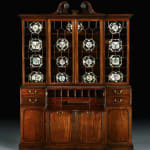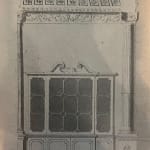Cabinets & Desks
A GEORGE III MAHOGANY SECRETAIRE-DRAWER BREAKFRONT-BOOKCASE ATTRIBUTED TO THOMAS CHIPPENDALE
Width: 74.5” / 190cm
Depth: 19.75” / 50cm
Further images
Provenance
The Collection Mr & Mrs John R. Donnell at Ker Arvor, Newport, USA (where pictured in situ)
Literature
C. Gilbert, The Life and Work of Thomas Chippendale (London, 1978), Vol.II, p. 48, fig. 45
Sir William Chambers, Designs of Chinese Buildings (1757)
Plate CXXXVIII (bookcases with broken pediments)
Plate LXV (library bookcases with glazed doors)
James Yorke, Chippendale Furniture: The Work of Thomas Chippendale and His Contemporaries in the Rococo Style (1986)
John Cornforth, “Chippendale and the Director”, Country Life, 5 May 1983
A George III Mahogany Breakfront Bookcase with Secretaire Drawer
Attributed to Thomas Chippendale, circa 1760
Overview and Attribution
This superb early George III breakfront bookcase exemplifies the finest English cabinet-making of the mid-18th century and is attributed to Thomas Chippendale. Executed in richly figured, dense mahogany, the bookcase is conceived on a grand architectural scale and constructed in eight parts, demonstrating the technical sophistication and aesthetic harmony that characterise Chippendale’s most accomplished commissions.
Architectural Design and Features
The upper section features a broken swan-neck pediment of open fretwork, centred by a platform supported on foliate-carved rosette terms, above a crisply carved dentil-moulded cornice. Four astragal-glazed doors enclose adjustable book shelves. Below, a projecting pagoda-form waist moulding introduces the lower section, where a central secretaire drawer is fitted with a well-appointed interior including pigeonholes and drawers, and an inset panel of tooled hide. It is flanked by additional drawers and four paneled cupboard doors enclosing further adjustable mahogany shelves. The original chased-brass rococo handles remain intact, and the whole stands on a solid plinth base.
Stylistic Influences and The Director
The design of this piece closely follows patterns published in both the first (1754) and third (1762) editions of The Gentleman and Cabinet-Maker’s Director, Chippendale’s seminal pattern book. Elements such as the swan-neck pediment, open fretwork, astragal glazing bars, paneled doors, and dentil cornice are all recurring features in Chippendale’s designs. The influence of chinoiserie is clearly present in the pagoda-form waist moulding and fretwork, while the handles exhibit the fluid asymmetry of French Rococo design—exemplifying Chippendale’s masterful synthesis of stylistic elements into a coherent, modern English aesthetic.
Comparative Examples and Supporting Evidence
A comparable design appears in a surviving drawing by Sir William Chambers for a study at Pembroke House, the London residence of the Earls of Pembroke, c. 1760–62. That design, likely executed in collaboration with Chippendale, features a nearly identical swan-neck pediment, supporting the attribution of the present piece.
Construction and Craftsmanship
The craftsmanship evident in this bookcase strongly supports Chippendale’s authorship. The construction is exemplary: the secretaire is fitted with meticulous precision; drawer linings are finely dovetailed in solid mahogany; and the fluent carving reflects the assured hand of a top-tier workshop. The breakfront format—allowing for modular transportation and installation—was a hallmark of ambitious architectural furniture design during this period.
Cultural Context and Interpretation
This bookcase represents Chippendale’s vision of the library as a refined expression of status, intellect, and modern taste. Through his seamless blending of Chinese, Gothic, and French influences, Chippendale created a fully resolved and highly functional work of art—one that speaks eloquently to the cosmopolitan ambitions of his clients and the enduring sophistication of Georgian design.







